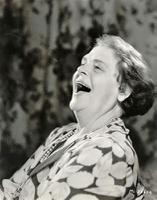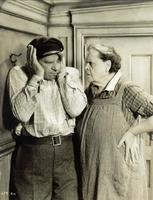Marie Dressler
Marie Dressler, neé Leila Marie Koerber, actor, writer (b at Cobourg, Ont 9 Nov 1869; d at Santa Barbara, Ca 28 Jul 1934). Marie Dressler was the daughter of an émigré music teacher. There is some dispute about her birth date; her crypt in the Hollywood Memorial Cemetery gives her birth year as 1871. Some sources claim her proper name was Leila von Koerber. But there is no doubt that during the last 4 years of her long career on stage and in film she was the most popular actress in the movies, and MGM boss Louis B. MAYER declared her to be one of his greatest stars.
By the age of 5, Leila Koerber was already performing on stage, and by 14 she played with an amateur company at Lindsay, Ont. By 1892 she had changed her name and found her way to Broadway, where she proved to be a popular light-opera singer and star on the vaudeville stage. She was a large, heavyset woman blessed with perfect comic timing. In 1909 she went to London, England, where she performed on the West End stages. Returning to America, she had a hit with Tillie's Nightmare, in which she played a "homely, boardinghouse drudge" named Tillie Blobb. The "King of Comedy," fellow Canadian Mack SENNETT, purchased the rights for his fledgling Keystone Studios and persuaded Dressler to come to Los Angeles to shoot a film version with another of his rising stars, Charlie Chaplin.
The film, called Tillie's Punctured Romance (1914), proved to be such a success that it was followed by Tillie's Tomato Surprise in 1915 and Tillie Wakes Up in 1917. After the fourth Tillie film, which Dressler wrote for herself and which was released under the title The Scrublady (1917), Dressler returned to the Broadway stage, her first foray into the movies coming to an abrupt end.
Back in New York City, Marie Dressler became involved with the movement for women's right to vote. She also supported the women in the chorus line when they went on strike against Broadway theatre owners and producers, which ultimately led to the formation of the Actors' Equity Union. These activities led her to be blacklisted and her career essentially came to an end. It was during this time that she wrote her first memoir, The Life Story of an Ugly Duckling, which was published in 1924.
With the advent of "talking pictures," Dressler returned to Hollywood and scored a major success when she appeared with Greta Garbo in her first sound film, Anna Christie (1930). This was followed by a string of hits and a revival of her career. Marie Dressler won the best actress Oscar for Min and Bill (1931), was nominated for Emma (1932), appeared in the all-star cast of Dinner at Eight (1933) and created the enduring character of "Tugboat Annie" in the film of the same name (1933).
With Dressler suffering from cancer, the last years of her life were difficult but she remained active and was showered with many honours. She was a friend of presidents and a frequent visitor to the White House, all the while campaigning for fair pay for her fellow actors. She died before she could complete her second memoir, My Own Story.
In 1992, the Vintage Film Festival was created to showcase films starring Dressler and her contemporary movie stars. The Marie Dressler Foundation presents the festival annually in Port Hope and her hometown of Cobourg, Ont, where there is also a Marie Dressler Museum. Canada Post issued a commemorative stamp featuring Dressler in 2008.

 Share on Facebook
Share on Facebook Share on X
Share on X Share by Email
Share by Email Share on Google Classroom
Share on Google Classroom





